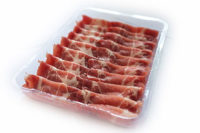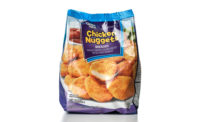From silver bullet to silver lining


|
Early on, according to a senior packaging manufacturing source, many meat processors were looking for real breakthroughs in materials that were sustainable. Now, most realize that there are no silver bullets, and sustainability is a much more complex proposition.
The easiest steps — and this by no means diminishes their impact — have been to go after low-hanging fruit by reducing energy consumption in their processes, thinning down their packaging materials and trying to redesign packages to take up less space during storage and distribution. One company has moved away from a paperboard sleeve on a lidded tray to a printed top-web. Yet another has moved to a thinner shrink film which enables them to reduce sealing temperatures, use less material and have fewer roll changeovers, because thinner material means more footage on the same roll.
Further evidence is the sense of increasing awareness among processors about the sustainability benefits of protecting their products from damage or spoilage, thus keeping more from entering the waste stream. The relative benefit of extending shelf life for an extra two days can greatly outweigh a packaging weight reduction, say, of 10 percent to 20 percent, according to this same packaging manufacturer. The sort of packaging technologies that deliver here are traditional ones like enhanced sealability, more robust gas barrier properties or unique package designs that can reduce material volume or portion products.
Those traditional technologies are also being examined in another way, says a product development veteran with 30 years of experience in the food industry. Some processors are looking to modify or change packages made currently from multi-layer materials — which would carry an SPI recycling code of 7 — to those that are more recycling friendly such as polypropylene or polyester. Certainly this would create another marketable point to communicate to shoppers. The critical caveat here is that in doing so the modified package maintains the performance characteristics required for its application, a task easier said than done in some cases.
Three years of recession and glacially sluggish recovery have left meat processors in a mood where they are less likely to invest in new capital or accept higher material costs when it comes to packaging. However, cost-saving programs are alive and well, with many companies working to improve yields and energy efficiencies to improve their bottom lines. Ironically, in scouring their packaging costs for any efficiency they can find, they have helped to change the expectations of sustainability to include a demonstration of economic value, not just environmental value.
Looking for a reprint of this article?
From high-res PDFs to custom plaques, order your copy today!







